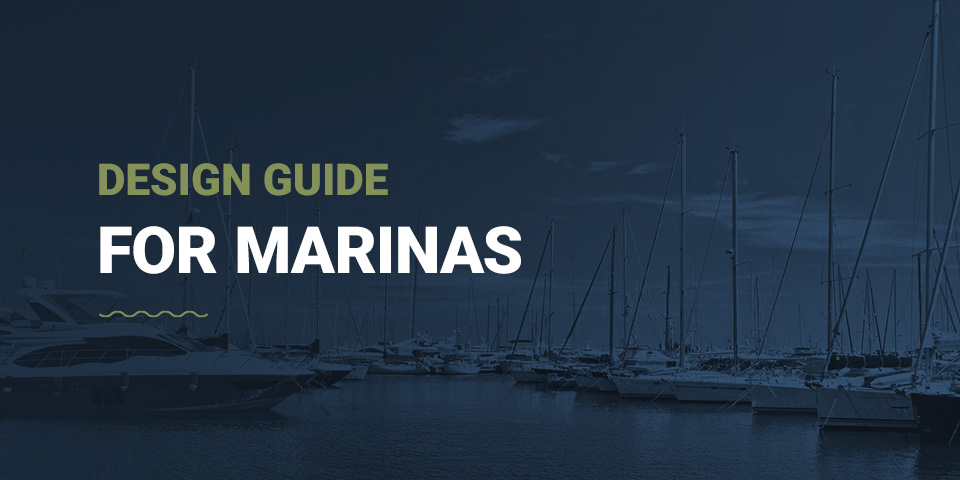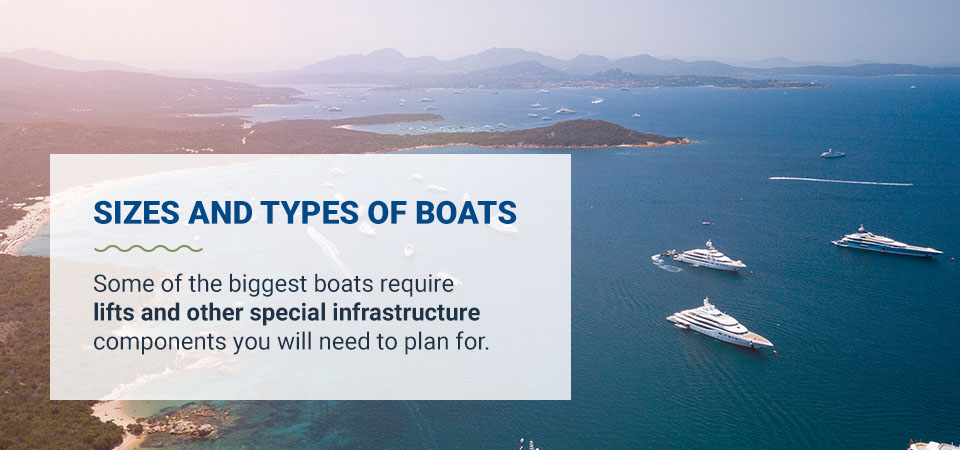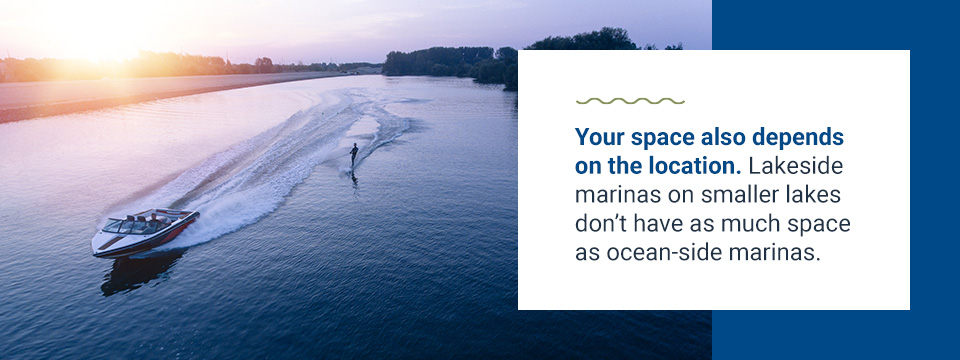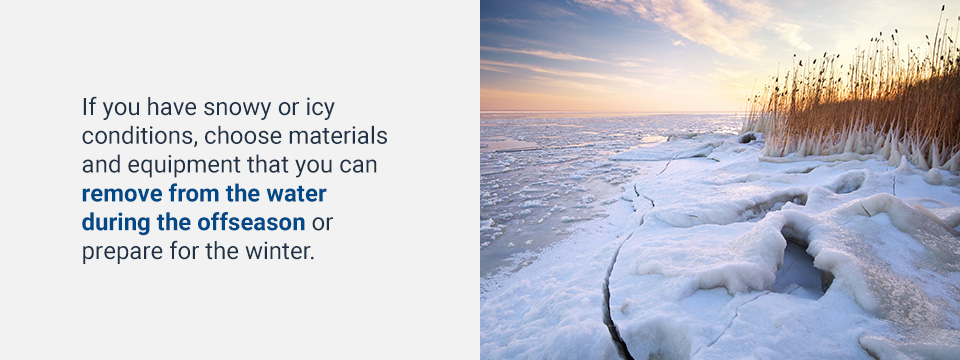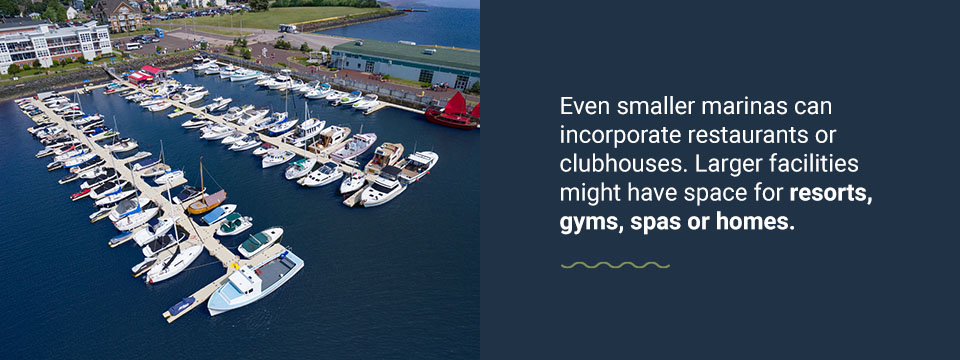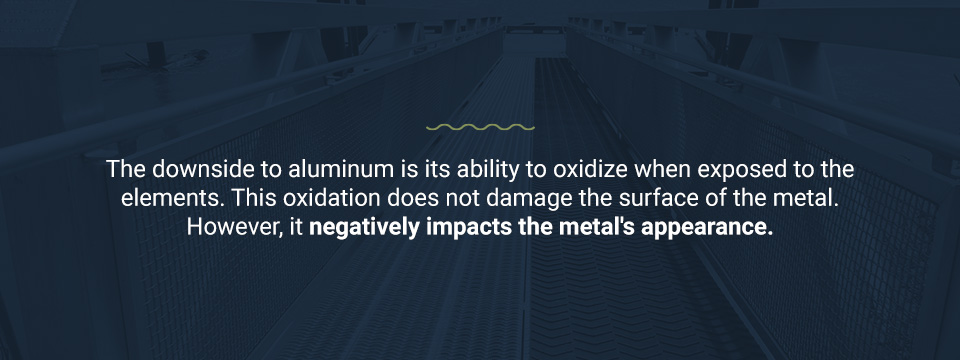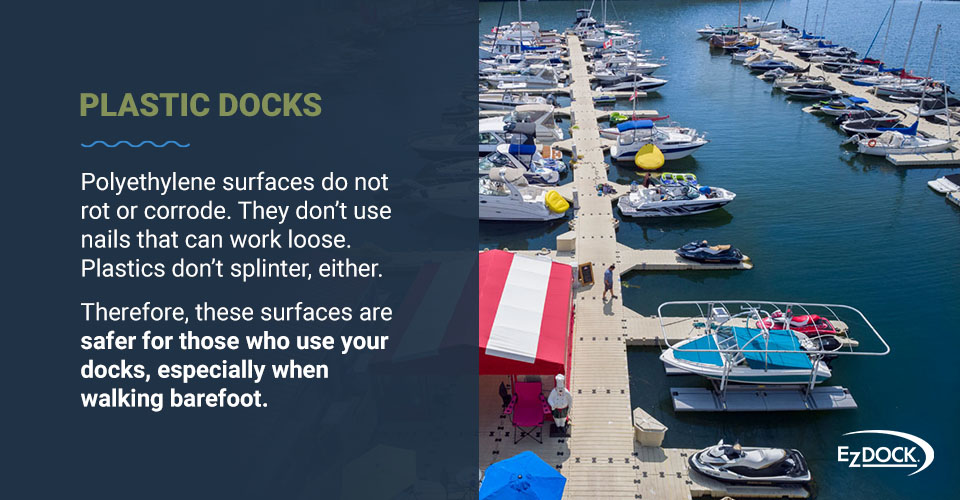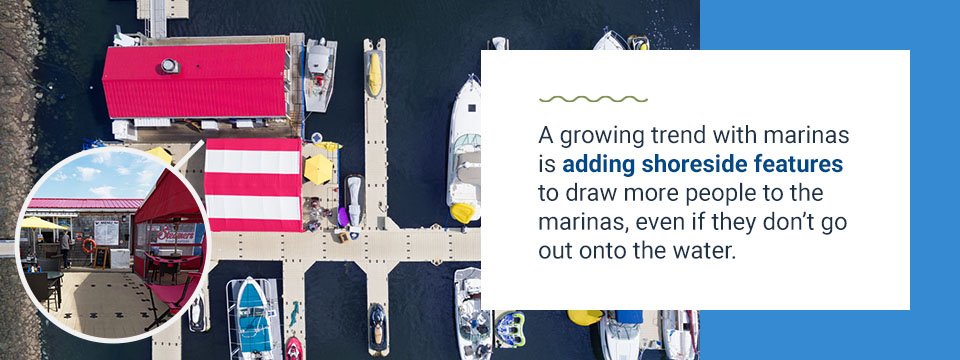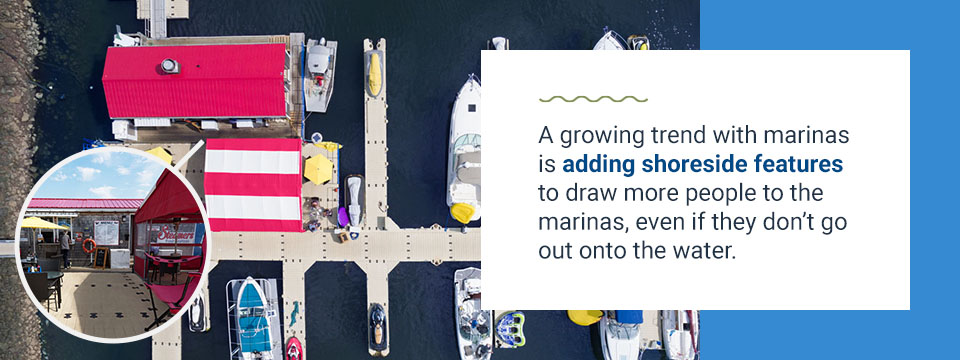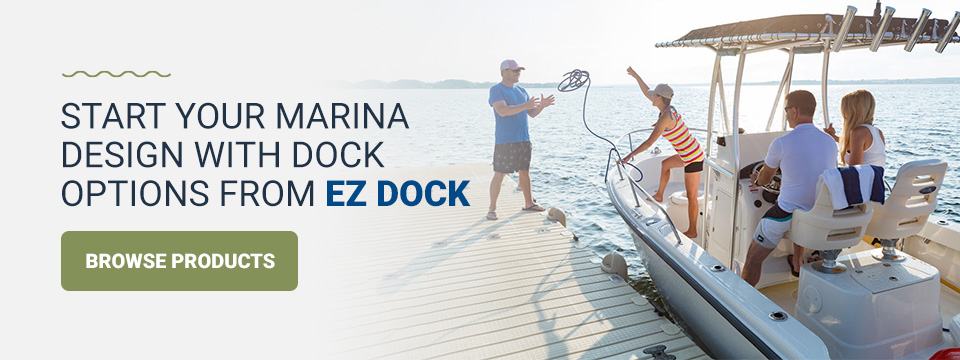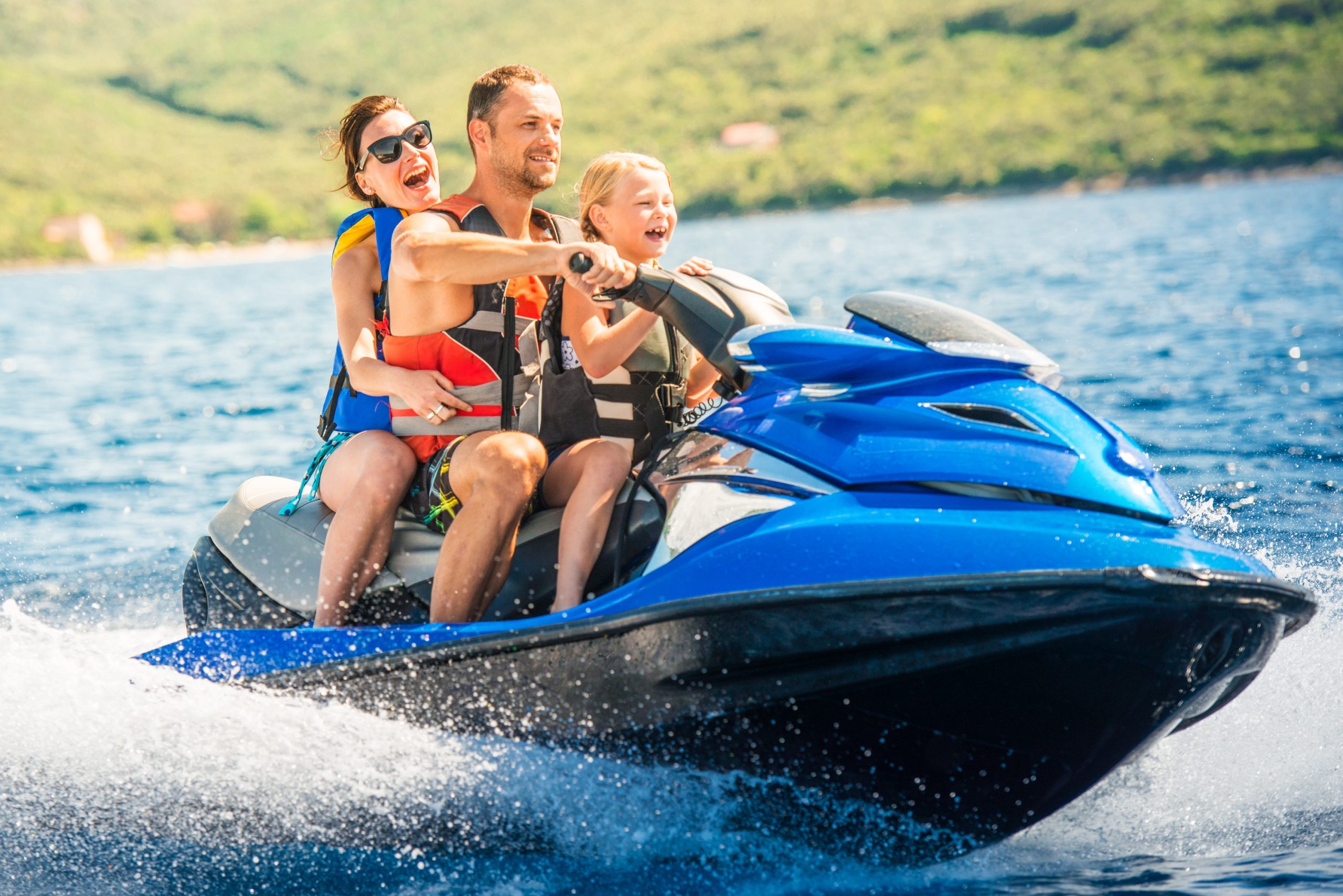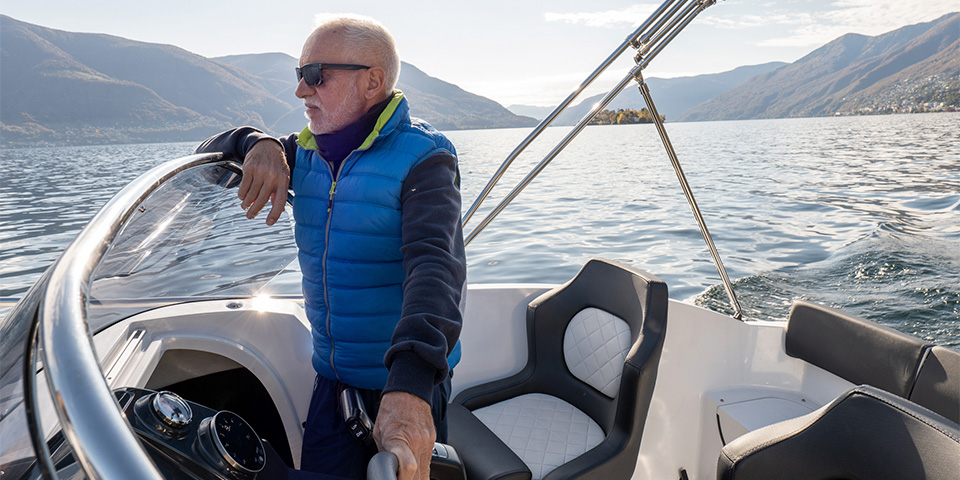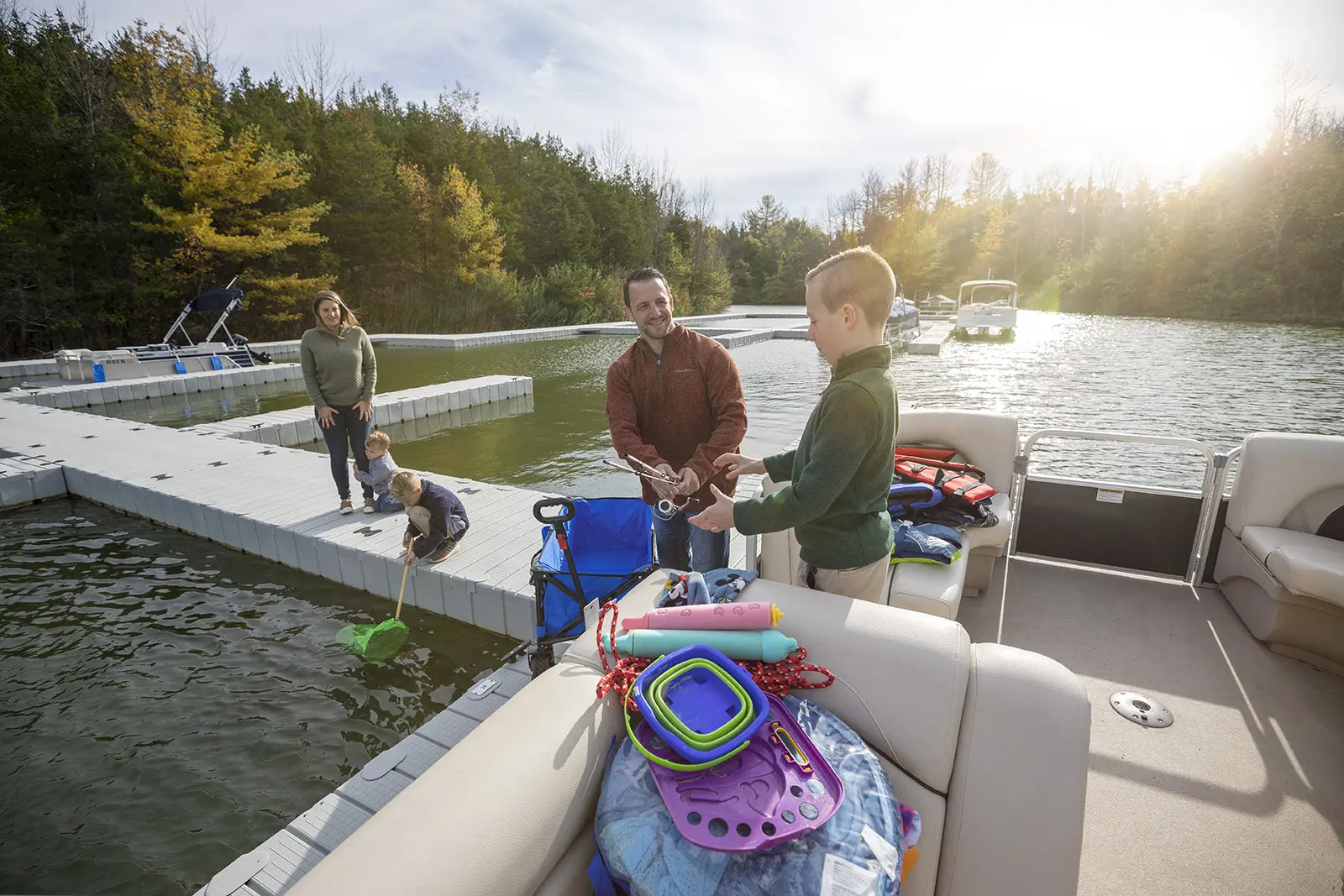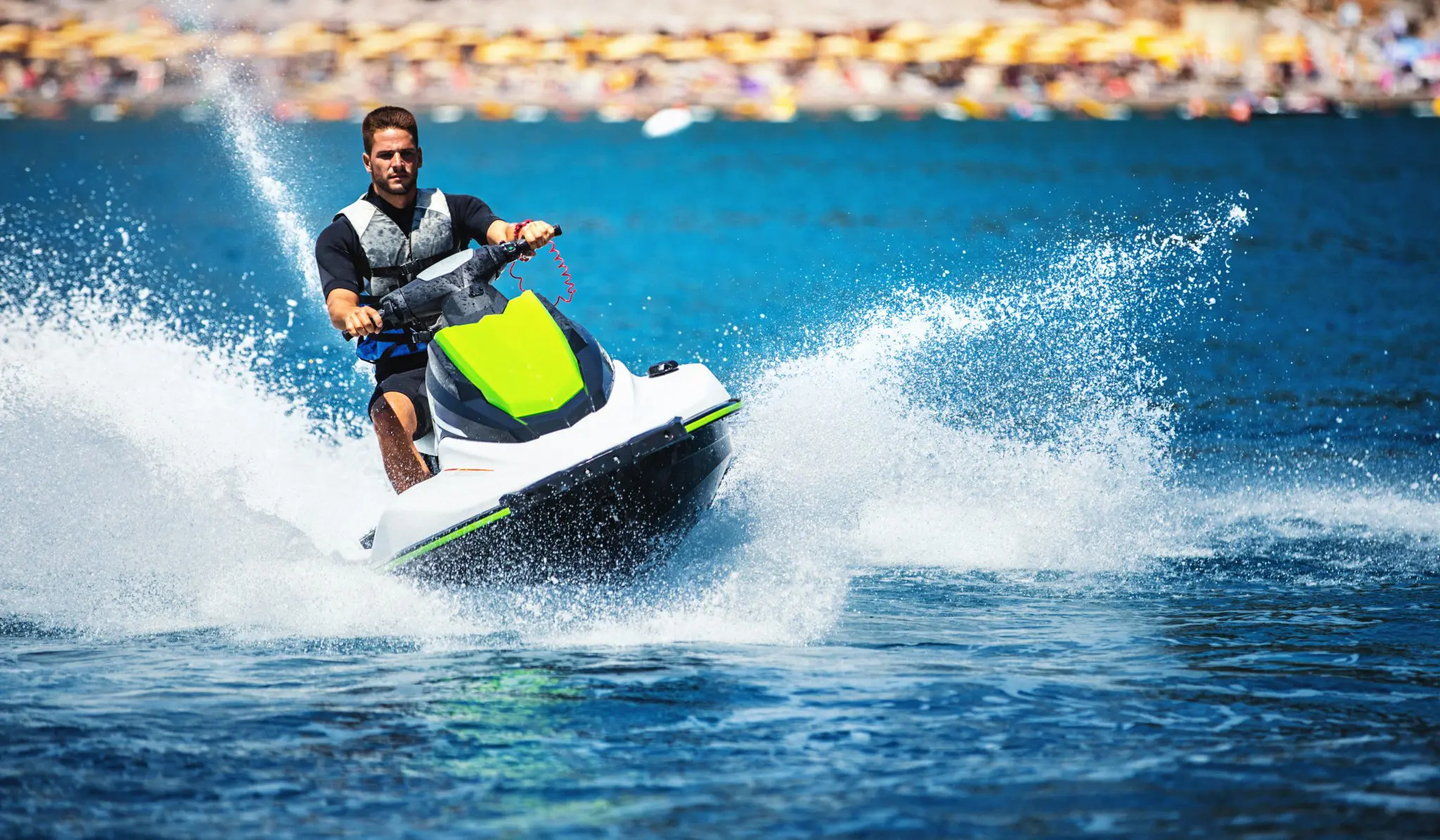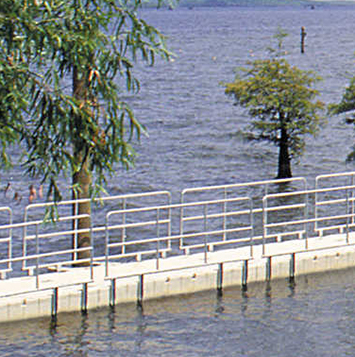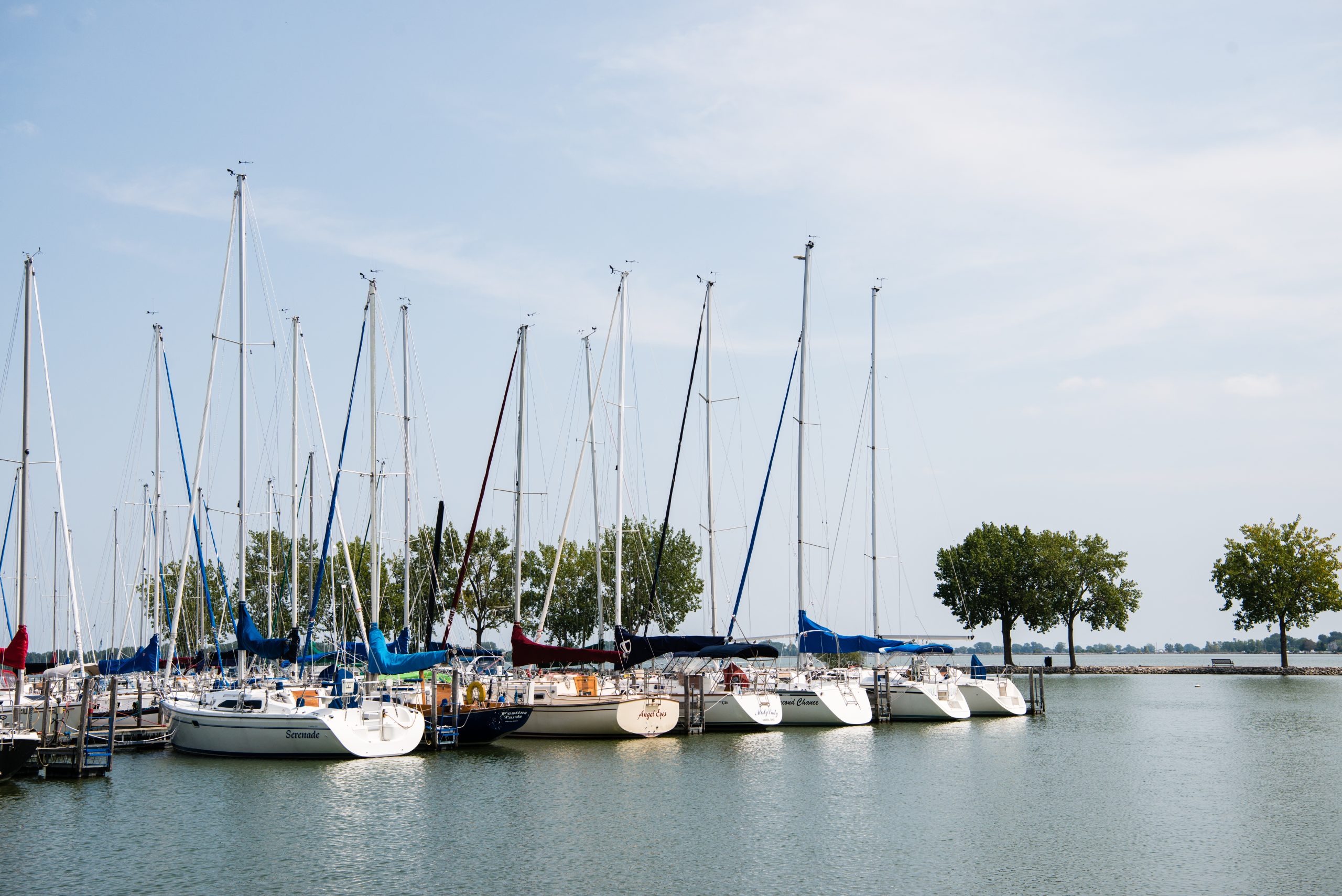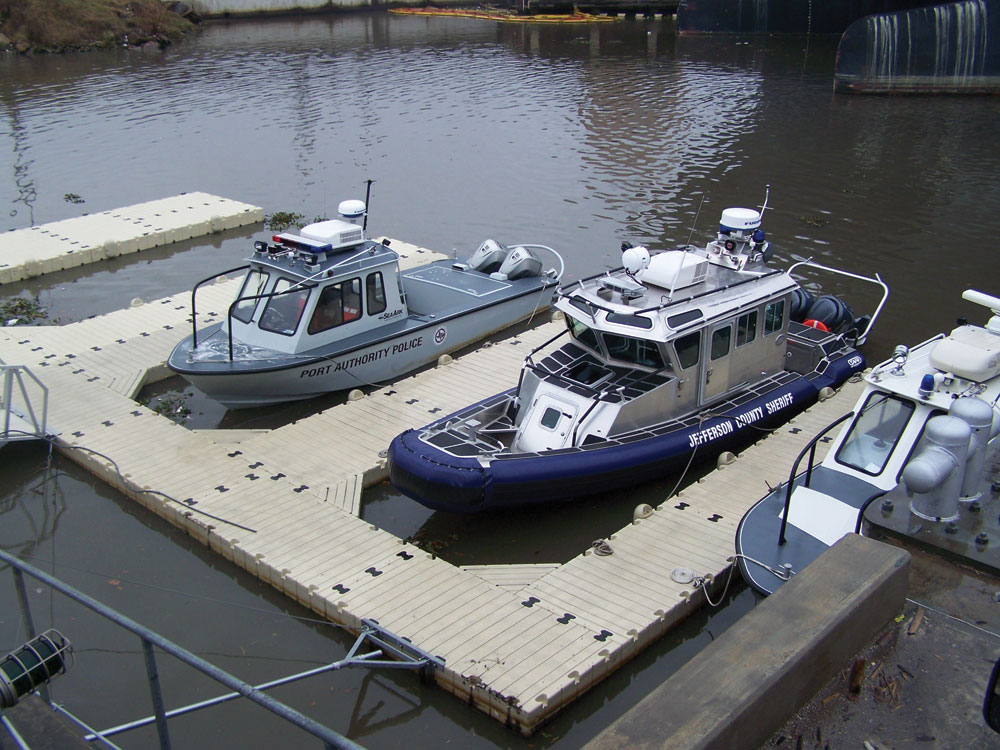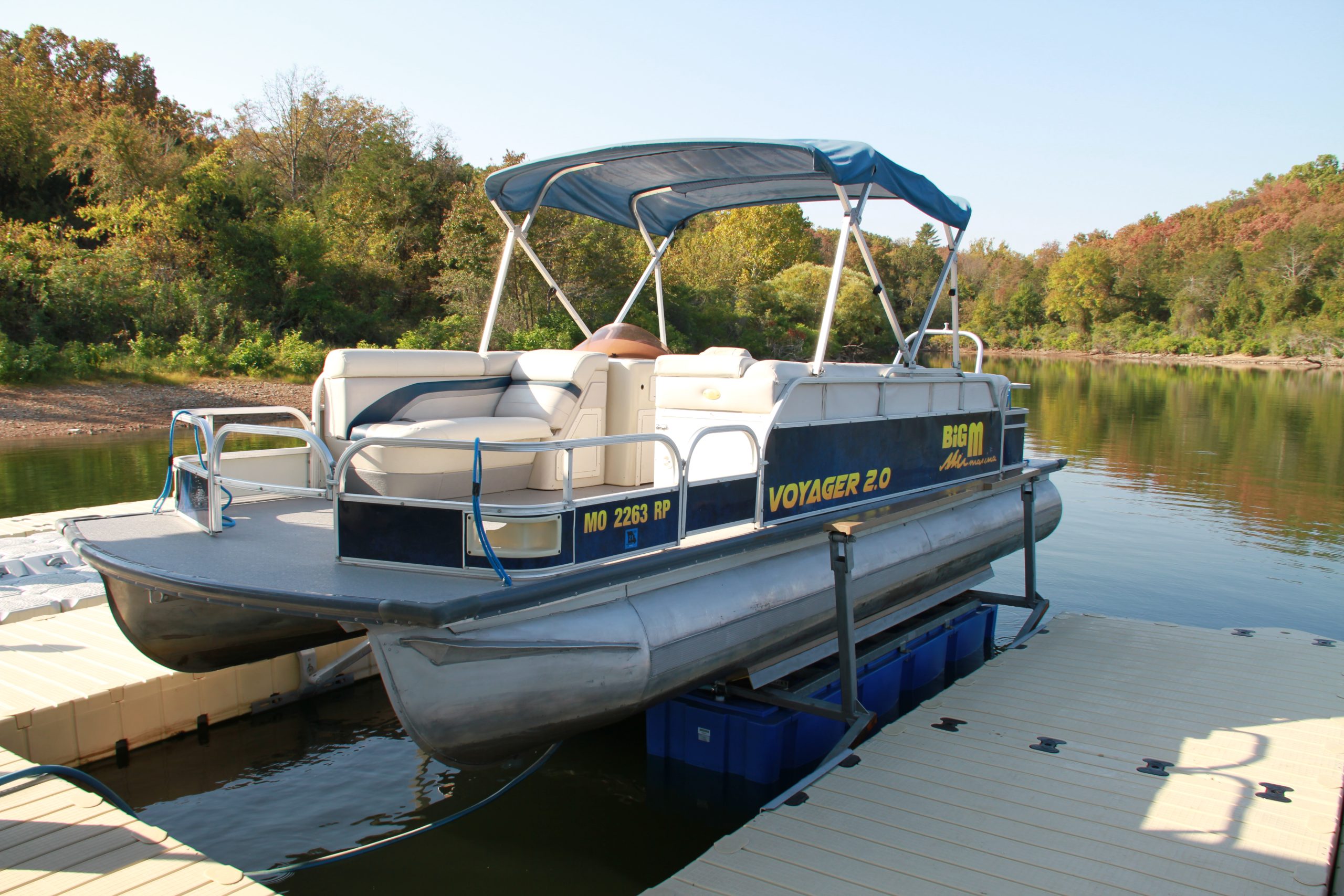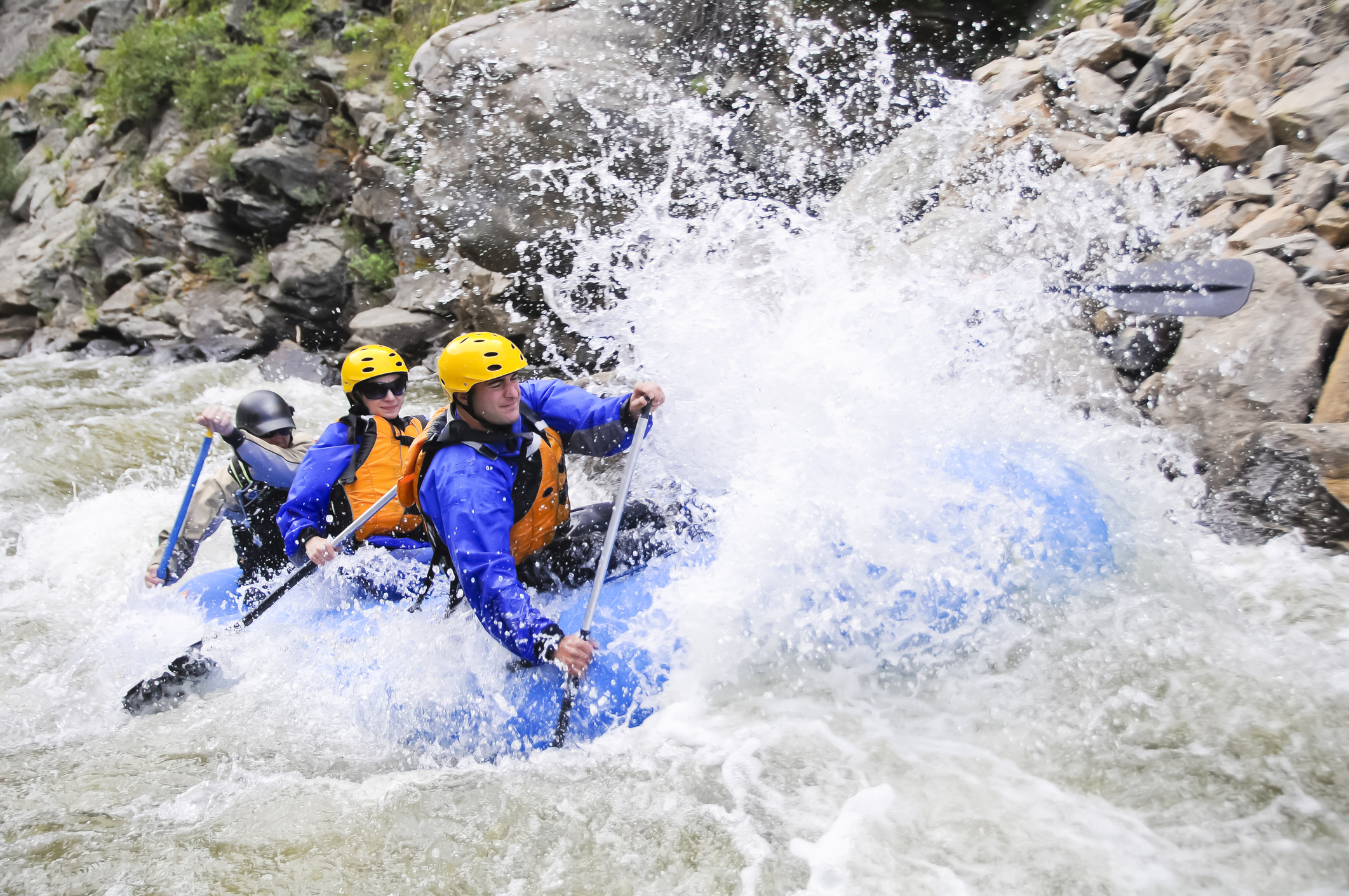Filters
Design Guide for Marinas
You don’t need to follow a step-by-step outline to create your perfect marina. Instead, use tips to ensure that you have the necessities. After you have the basics in place, look to marina design trends to create a modern marina that will be practical and attractive.
To get started on your marina design, understand the factors that will influence the final look of your marina, know the best materials to use and find trends to match the style of your marina users.
Read the full article or jump to a specific section:
- How to Design a Marina
- Choosing the Right Material
- Marina Design Trends for the Future
- Start Your Marina Design With Dock Options From EZ Dock
How to Design a Marina — Factors That Affect Marina Design
When designing your marina, you must consider more than aesthetics when choosing components and the overall layout. These factors impact everything from the number of berths you make available to the type of dock material you choose. Examine these factors when creating the plan for your marina to ensure project feasibility and its ability to provide a safe, useful site for boaters.
1. Marina Users Expectations
What type of people will use your marina, and what will they expect to find? If you create a marina for local resorts to provide their guests with personal watercraft or yachts, you may not need as much space as you would for a marina in a seaside community of boating enthusiasts, each with their own yacht.
The users and their expectations will also help you decide whether to create a utilitarian marina to serve basic needs or a luxury destination where people can get on the water on their boats and enjoy recreation along the water. These upscale marinas may include restaurants, high-end design and places to gather and socialize.
2. Sizes and Types of Boats Used at the Marina
What types of boats will dock at your marina? Large yachts require more space and larger slips. Some of the biggest boats require lifts and other special infrastructure components you will need to plan for.
Megayachts may require side-tie space to accommodate these vessels. Catamarans are increasingly popular in some parts of the country and often don’t fit within common slips. These wider vessels often require more space than other sailboats and wider slips.
Some marinas, especially those situated in inland, freshwater locations, may have a greater demand for a higher number of smaller slips. Take stock of the demand in your area before choosing the sizes of slips you will need. Knowing what your marina can handle will ensure your success in attracting boaters to dock at your site.
3. Regulatory Requirements
Depending on where you will build, you may be under regulations to control the size and number of slips that your marina can have. These regulations may prohibit you from building a marina with as many spaces for large vessels as you want.
One way some marina owners have balanced local requirements for public access and the need for fewer, larger slips has been to extend docks and narrow them to create wider berths. These extra-wide berths can accommodate the larger yachts that need docking space in many marinas. Always find out if there is a need to dock large boats before making design choices for your marina.
Determining demand is especially vital if you need to fit larger slips into your marina while meeting regulatory requirements. Without a local demand, you do not need to change your design beyond those required by local agencies.
4. Space Available
How much space you have available is important, especially if regulations mandate a minimum number of slips in your space. The amount of room you have will help you determine the number and arrangement of slips. You will have to decide what to do with the space available on the shore.
Your space also depends on the location. Lakeside marinas on smaller lakes don’t have as much space as ocean-side marinas. Nor do the former require as much room since the boats used on smaller bodies of water tend to be smaller or personal watercraft.
Such a space on a lake may need kayak storage space and a launch at the marina. These non-powered boats appeal largely to those getting into water sports and tourists visiting lakes or other natural areas. If your marina will serve a lakeside spot, reserving space and launch points for kayaks or paddleboards will help you make the most of your limited space.
If you have ample shore space, consider installing additional amenities that have become more popular lately. You may want to include rooms for owners or captains, swimming pools or gyms. These options allow people at your marina to have a more rounded experience. Adding a swimming pool also prevents people from using the marina waters when they want a dip, keeping your facility safer.
5. Budget
Your budget will dictate the the project’s direction and how much you can afford to construct. Marina construction, like any other real estate building, depends greatly on your location. Sites that may see use most of the year, such as in southern Florida, have a high demand, and the cost for construction and land may be higher than seasonal marinas on lakes in other parts of the country.
Find out about local costs of construction for a marina to determine the size of a site you can afford. Projecting potential income from berthing vessels and other sources can help you determine your ability to earn back your investment in the marina. If your marina meets a high demand, you will likely have more income and get a faster return than a site that will not see as much income from berths and users.
Don’t forget to incorporate operating costs when estimating final profits and your return on investment. High maintenance components in your marina, such as wooden docks, may cost less initially but require more maintenance and higher costs over time.
6. Weather Considerations
What type of weather will your marina experience throughout the year? If you have snowy or icy conditions, choose materials and equipment that you can remove from the water during the offseason or prepare for the winter. Floating docks are a removable option that you can pull off the water in the off-season. Polyethylene also stands up well against freezing weather that might damage wood for structures you cannot remove.
Additionally, you must have plans for protecting your marina from hurricanes or other storms. Preserving the vessels inside the marina from storm damage throughout the hurricane and thunderstorm seasons may require installing large breakwaters and floating attenuators. These may prevent serious property loss from heavy waves during storms or at other times.
Additionally, you must have plans for protecting your marina from hurricanes or other storms. Preserving the vessels inside the marina from storm damage throughout the hurricane and thunderstorm seasons may require installing large breakwaters and floating attenuators. These may prevent serious property loss from heavy waves during storms or at other times.
7. Safety Features
Safety features should always be part of your marina plan. You must have proper lighting to prevent tripping and security hazards. Lights and signs should also indicate exit routes in cases of emergencies requiring evacuation.
Fuel, engines and other ignition sources present a serious fire hazard. Your marina must have fire suppression systems that include fire extinguishers, alarms and smoke detectors. Check with your local fire authority for the specific number and location of these items based on the size and arrangement of your marina.
First aid kits and AED units are medical features to include around the marina. Post signs to indicate the locations of these devices to ensure even visitors can find them quickly.
8. Shoreside Amenities
Will you install shoreside amenities at your marina? What types will you include? Bathrooms, showers and offices are standard options. However, you may want to include other types of features to draw users to your marina.
Even smaller marinas can incorporate restaurants or clubhouses. Larger facilities might have space for resorts, gyms, spas or homes. The choices of these amenities depend on the space you have, who your marina will serve and where you are located. You will likely get more profit from these amenities if you have a marina that can operate most of the year instead of sites with shorter seasons.
Choosing the Right Material — What You Need for a Marina
Materials used in a marina should stand up to wind, sun, rain, snow and ice. Some surface materials will require more regular maintenance to preserve their integrity and appearance. To reduce overall time spent keeping the marina looking good over the years, consider low-maintenance, durable materials for docks and other surfaces. As with all marina decisions, the type of material you choose will be specific to your site and the aims you have for your marina.
1. Wood
Wood is a traditional material for marina components. When you have docks built from wood, you must choose a type of wood that will stand up to the elements. Hardwoods, such as ipe, are dense and can resist rot better than other types of wood. However, even these woods require regular cleaning and oiling to protect the surface from water intrusion.
Another material to use is pressure-treated wood. This wood type needs cleaning, sanding and staining to restore its color and protect it from water damage. Using any type of wood for docks or other structures at a marina is a naturally beautiful option. But, it is a high-maintenance one. Factor in the cost of maintenance if you choose any wood components for your marina.
2. Aluminum
Aluminum is lightweight, rot-resistant and corrosion-resistant. It works well for portable features such as ladders. Cleaning aluminum requires little more than baking soda or vinegar for environmentally friendly stain removal. The downside to aluminum is its ability to oxidize when exposed to the elements. This oxidation does not damage the surface of the metal. However, it negatively impacts the metal’s appearance.
3. Concrete
Concrete for docks is another popular option because it lasts a long time and allows for customization. Some marina owners can use concrete and galvanized steel in docks to allow for the installation of swimming pools within the docks.
Other concrete uses around a marina include breakwaters, piles and concrete tiles. Concrete breakwaters can have heavy-duty designs that control larger wakes produced by bigger boats. Tiles made from concrete have places in decking and other structures. With modern concrete additives and treatments, this material can now stand up to the rigors of climates with very cold, snowy winters. In the past, this type of application for concrete would not have been feasible, which led to the myth of using concrete in only mild climates.
4. Plastic
Plastics today are durable and almost maintenance-free. They are used for many components such as floating docks, benches, gangways and more. Polyethylene, a type of plastic used at marinas, does not rot or corrode. It also does not have organic components that would attract bugs to eat away at it. You never need to sand, paint or stain marina components made of polyethylene, making it a good option when you want long-lasting, low-maintenance components.
With modern designs, the surfaces of polyethylene components do not become hot underfoot. They also don’t use nails that can work loose. Plastics don’t splinter, either. Therefore, these surfaces are safer for those who use your docks, especially when walking barefoot.
5. Steel
Stainless steel or galvanized steel provides strong, rot-resistant materials for marinas. This metal serves as the supporting part of structures such as piles or docks. When using stainless steel, the metal can show rust stains. Painting the metal hides these stains and prevents future corrosion.
Another option for steel piles is to use plastic coverings to protect them from the elements. These sleeves fit over piles giving your marina the benefit of steel strength without the appearance of rust on the outside of the piles. The sleeves let you customize the color of the piles to create a more visually impressive marina.
Marina Design Trends for the Future
Marina design has style changes the same as any other design field. However, these design fads last longer than fashion trends and have more impact on who can use your marina and who wants to use it.
Many of the most recent changes in marinas reflect the evolving needs of the users. People want to have a destination at the marina instead of just a place to dock their boats. When creating a marina to last for years, consider this demographic and other future-thinking design trends.
1. Incorporating Shoreline Amenities and Attractions
Marina users today don’t spend all their time on the water. A growing trend with marinas is adding shoreside features to draw more people to the marinas, even if they don’t go out onto the water.
Amenities range from simple restaurants to more complex resorts. Some marinas have gyms or spas, while others include swimming pools on the shoreside. A benefit of these extra amenities comes from the added income they bring to help support the operation and boat slip maintenance.
2. Creating Inviting Spaces
Marina users today want inviting spaces that are pleasant to be in and provide their boats safe harbor. A visually appealing space makes boat owners feel more comfortable at the marina. Invest in materials requiring less maintenance or conduct more frequent care of your surfaces.
Inviting spaces also include providing areas for each marina user to feel comfortable. Give them places to gather with other boating enthusiasts, such as a clubhouse for the marina. Your marina should also have a clear layout that makes it easy for owners to reach the berths for their vessels quickly.
Other ways to make the marina more inviting include incorporating high-speed Wi-Fi and adding in-slip pump-outs. LED lighting around the marina attracts fish and those who enjoy watching them in the water.
3. High-End Construction and Environmentally Friendly Materials
As people spend more money on their boats, they expect to store them in equally well-invested spaces. Therefore, your marina should reflect quality by using high-end construction processes and beautiful materials. Extra trim, added decorative features and lavish materials are commonly used in marinas and expected in high-end facilities. Incorporating these decorative elements enhances the aesthetic appeal of your marina and creates a more enjoyable place for marina users.
Marina users and local governments also have concerns about the environment. Choose materials that reduce the marina’s impact on the local ecosystem. For instance, choose polyethylene docks instead of wood because the former does not require staining. Some stains could wash into the water and harm the environment. More environmentally friendly options for building and maintenance show you are investing in preserving waterways and building your marina with the future in mind.
4. Customization of Materials, Styles and Colors
Older marinas did not often have colorful designs. Many marinas today opt for customized colors, styles and materials. Instead of standard concrete for decks, marinas today choose stamped or colored concrete for a more decorative touch.
Color-coding docks and using names to personalize individual docks creates a greater feeling of ownership for those who use the marina. Colorations make the space more inviting and encourage more investment from the users who appreciate the personalized touch.
5. Bigger Breakwaters and Attenuators
Stronger hurricanes and larger boats both increase the chances of wakes or waves impacting a marina. Future marinas will need bigger breakwaters or floating attenuators. Breakwaters need to be larger to meet the needs of marinas that face megayacht wakes and hurricane-produced waves. The extra size also needs additional durability to provide the strength to withstand higher waves.
Not every marina will be able to install fixed breakwaters. In the future, floating attenuators may become even more popular as natural harbors disappear in their availability, and local governments make obtaining permits for fixed breakwaters difficult.
6. Alternatives to Hardwoods for Decking
Marina owners are embracing alternative materials for decking to hardwoods. Despite the relatively lower cost of wood for decks, they require extra care and maintenance and don’t last as long as other materials. Wood decking needs frequent sanding and oiling or staining to keep it looking good. Pressure washing these decks is not possible as the pressure can create splinters.
Alternatives requiring less effort, such as polyethylene and concrete, are more popular today. These options don’t need painting and can allow deeper cleaning with pressure washing.
Start Your Marina Design With Dock Options From EZ Dock
Your marina should start with sturdy, long-lasting dock options. With EZ Dock, you have choices for polyethylene docks that serve as maintenance-free alternatives to wood docks. These docks have low care requirements because they don’t rust, splinter or rot. Plus, they are non-slip and feel good under bare feet, even during the summer heat.
Our modular docks are simple to customize to your planned marina’s needs. Request a quote for one of our docks from EZ Dock. Or contact us if you’d like to work with a team member to customize your project based on your timeline, budget and other parameters. Start your marina design with premium docks from EZ Dock.

